#seb'a baharat
Explore tagged Tumblr posts
Text
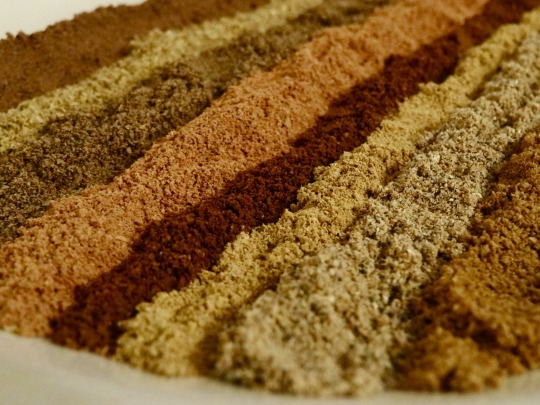
[ID: An extreme close-up of ground spices in various shades of brown and orange laid out in lines on a plate. End ID]
سبع بهارات فلسطينية / Seb'a baharat falastinia (Palestinian seven-spice)
Seb'a baharat is one of a few spice blends often referred to in English simply as “baharat” (the plural of Arabic بهار / bahar, “spice”). A warm, earthy blend, it is commonly used to season meat, fish, and poultry in the Levant, Eastern Arabia, and Egypt, where recipes differ from region to region and from person to person. Common ingredients include cumin, cardamom, black pepper, nutmeg, and cinnamon.
Palestinian versions of seb'a baharat are usually dominated by allspice, black pepper, and cinnamon, giving them a pungent and sweet head; nutmeg, cloves, and cardamom provide additional warmth, while cumin and coriander often round out the blend with earthiness and a hint of florality. Ginger is also an occasional inclusion.
By the early 2010s, decades of Israeli taxation on exports and imports of non-Israeli goods had eroded Palestinian economic and culinary self-determination; Israel had instituted further blockades of the Gaza border in 2007, leading to a sharp decline in exports. Several farmers in Gaza turned to growing spices and herbs, including cumin and ginger, on their farms with the intention of finding a profitable market for them in Europe. However, frequent border closings, punitive export taxes, and Israeli shooting at Palestinian farmers who were attempting to work their land, made the plan unviable.
More recently, Palestinians have continued to work to find new ways to produce food despite shrinking access to arable land and fresh water. Resisting Israeli targeting of Palestinian food self-sufficiency is a matter, not just of subsistence and economic power, but of identity and dignity.
Today, Israel's total siege of Gaza continues as civilians run out of food, water, power, and medical supplies. Medical Aid for Palestinians (MAP) has put out an urgent call for donations to provide medical supplies to hospitals when supply lines reopen. Also contact your representatives in the USA, UK, and Canada.
Ingredients:
1 Tbsp ground allspice (6.6g; 1 Tbsp + 1 tsp allspice berries)
1/2 Tbsp ground black pepper (6.2g; 1/2 Tbsp black peppercorns)
1/2 Tbsp ground cinnamon (5.3g; 1 large stick Chinese cassia)
1 1/4 tsp ground coriander (2g; 1 1/2 tsp coriander seeds)
1 tsp ground nutmeg (1.4g; 1/2 nutmeg)
1 tsp ground cloves (2g; 1 1/4 tsp whole cloves)
1 tsp ground cardamom (scant 1/2 Tbsp pods; 2.6g just seeds)
3/4 tsp ground cumin (2.1g; scant tsp cumin seeds)
Instructions:
1. In a mortar and pestle or using the flat of a knife, roughly crush nutmeg and cinnamon.
2. In a dry skillet over medium heat, toast whole spices one at a time until each is strongly fragrant. Remove from heat and allow to cool in a single layer on a large plate.
3. Grind all spices together in a mortar and pestle or a spice mill. Pass through a sieve to remove large pieces. Store in an airtight jar in a cool, dark place.
285 notes
·
View notes
Text

[ID: A conical pyramid of a brown spice blend surrounded by whole spices including allspice, cardamom, and rose petals. End ID.]
سبع بهارات المصرية / Seb'a baharat al-misria (Egyptian seven-spice)
Seb'a baharat is one of a few spice blends often referred to in English simply as "baharat" (the plural of Arabic بهار / bahar, "spice"). It is also sometimes called بهارات الحلبية (baharat al-Halabia), "Aleppo spices," due to its origins in Aleppo, Syria. A warm, earthy blend, it is commonly used to season meat, fish, and poultry in the Levant, Eastern Arabia, and Egypt, where recipes differ from region to region and from person to person. Common ingredients include paprika, cumin, cardamom, black pepper, nutmeg, and cinnamon.
Egyptian versions of the blend foreground sweet, warming spices, with allspice dominating the mix and black pepper, cardamom, clove, nutmeg, cinnamon, and ginger rounding it out. Occasionally, bay leaves and dried rosebuds are also added. The result is an intensely aromatic, floral, slightly camphorous blend that's great for marinades, dry rubs, and roasting.
Recipe under the cut!
Patreon | Tip jar
Ingredients:
Makes about 2/3 cup
20g (1/4 cup) allspice berries (كبابة صينى \ بهار حلو)
18g (2 Tbsp) black peppercorns (فلفل اسود)
6g (1 Tbsp; 25) green cardamom pods (حبّهان \ هال)
5g (one large stick; 1/2 Tbsp ground) Chinese cassia cinnamon (قرفة)
3g (one small) nutmeg (جوزة الطيب)
2g (1 tsp) ground ginger (زنجبيل)
1g (1/2 tsp; 20) whole cloves (مسمار)
1g (1 tsp) dried rosebuds (زر الورد) (optional)
0.5g (3-4) Mediterrannean bay laurel leaves (ورق لاورا) (optional)
2g (1/2 tsp) cumin seeds (كمون) (optional)
1.7g (1/2 tsp) coriander seeds (كزبره) (optional)
Despite the name, seven-spice does not always feature exactly seven spices. The core components of most Egyptian blends are the first seven spices listed in these rough proportions, with bay leaves and rose buds being optional additions; sometimes the blend mixes savory and warming spices, with cumin and coriander being added, or taking the place of allspice, nutmeg, or ginger. Rarer additions are thyme, gum mastic (مستكه), and paprika. You should change the blend to suit your own taste.
Instructions:
1. In a mortar and pestle or using the flat of a knife, roughly crush nutmeg and cinnamon.
2. In a dry skillet over medium heat, toast whole spices one at a time until each is strongly fragrant. Remove from heat and allow to cool in a single layer on a large plate. The bay leaves will only need to toast for a moment or two.
3. Remove skillet from heat and toast ground ginger, stirring constantly, for about 30 seconds until fragrant. Remove from skillet.
4. Grind all spices together in a mortar and pestle or a spice mill. Pass through a sieve to remove large pieces. Store in an airtight jar in a cool, dark place.
123 notes
·
View notes
Text
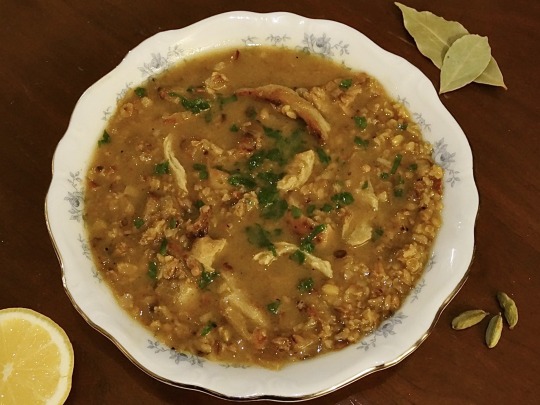

[ID: A greenish-brown soup with an herb garnish in a bowl surrounded by a halved lemon, green cardamom pods, and bay leaves, followed by a close-up of the same soup. End ID]
شوربة الفريكة / Shorabat al-frika (Green wheat soup)
Frika (فَرِيكَة or فَرِيك; also transliterated "freekeh," "frikeh," or "farik") is durum wheat harvested in the early spring, while the grain is green, unripe, and tender. Durum wheat, or semolina, is a different species of wheat than that which is ground to produce all-purpose flour (common wheat, or bread wheat); it is used to make couscous (كُسْكُس), bulghur (بلغور), and many types of pasta, and is widely consumed in North Africa, the Levant, and the Arabian peninsula. After harvest, unripe durum is sun-dried and then set ablaze in piles to burn off the straw and leave just the heads of wheat, resulting in a nutty, smoky flavor; the heads are then vigorously rubbed, traditionally by hand, to remove the bran. Frika is named after this last process; the word comes from the verb "فَرَكَ" "faraka," "to rub."
A staple in Palestine, shorabat al-frika (with diacritics, Levantine pronunciation: شُورَبَة الفْرِيكَة) is often eaten as an appetizer with the fast-breaking meal during Ramadan. It may contain nothing more than an onion, olive oil, frika, and water, but sometimes contains meat (usually chicken, but also beef or lamb), green chili peppers, and spices including cardamom, black pepper, bay leaves, turmeric, cumin, and seb'a baharat; some people today like to add chickpeas. Shorabat al-frika is often prepared with the chicken broth obtained by boiling chicken to make musakhkhan (مُسَخَّن), and served alongside it. It is a warming, filling, and earthy soup, with a complexity of flavor imparted by the frika itself: a fresh tartness due to the unripe grain, and a roasted aroma due to its harvesting process.
Shorabat al-frika is in keeping with a Palestinian food ethos of using simple, local ingredients to their fullest potential. Frika itself is sometimes thought to symbolize adaptability and resilience, as it was often eaten in times of scarcity when other crops were not yet ready to be harvested. Legend holds that it was discovered in a time of similar necessity: when villagers in the eastern Mediterannean tried to salvage a field of wheat that had been burned by ambushing soldiers, they found that the grain was still edible beneath the blackened chaff, having been saved from the fire by its moisture.
Frika, due to its centuries as a staple in Palestine, has also come to symbolize acceptance, Palestinian history, and connection to the land and community. In the Palestinian diaspora and amongst internally displaced people in Palestine, food is conceived of as a form of connection to homeland across distance; continuing to make Palestinian food, and remembering or using baladi ("native," "from my country") varieties of grains, produce, and herbs, is a link to the land and an expression of the hope to return.
By the same token, though, frika has come to represent Palestinian displacement and "cultural obliteration," per Rana Abdulla. One of the ways in which Israel rhetorically justifies its existence is by claiming sole ownership of an old, organically arising culture rooted in the land: the easiest way to do this is, of course, to rebrand what was already there. Food connects and combines language (in terminology and pronunciation), culture, history, climate, and land into one web of discourses, and is therefore a prime site for colonial myth-making and ideological nation-building. Thus a construction such as "Israeli freekeh" is, in fact, an intensely political one.
Nevertheless, frika continues its life as a symbol of connection, community, and resistance during adversity in Palestine. Nasser Abufarha, of the Palestine Fair Trade Association, noted in 2015 that more and more Palestinians across the West Bank were harvesting some of their wheat early to make frika, rather than relying on cheaper, imported rice. As of October 23 2023, and in defiance of an Israeli air raid which destroyed their kitchen in 2014, Jamil Abu Assi and his cousins were using frika, alongside lentils and rice, as staples in distributing food to thousands of refugees per day in Bani Suhaila, near Khan Younis. Others in the community donated ingredients or volunteered to distribute meals.
Support Palestinian resistance by contributing to Palestine Action's bail fund or to Palestine Legal's defence fund, or by attending court or making a sign to support the Elbit Eight.
Ingredients:
1 cup (170g) frika baladia (فريكة بلدية), Levantine frika
4 cups water, or vegetarian chicken stock from concentrate
1 large yellow onion, chopped
1/4 cup extra virgin olive oil
1 green chili pepper (فلفل أخضر حار), sliced (optional)
1/2 tsp ground black pepper (فلفل اسود)
5 cardamom pods (حب هال)
2 Mediterannean bay leaves (ورق غار)
250g chicken (or beef) substitute, torn or cubed (optional)
Salt, to taste
Parsley, to garnish
Halved lemon, to serve (optional)
I have kept the spices relatively simple, as most cooks do, to highlight the earthy end of the taste spectrum and to allow the flavor of the frika itself to come forward. Most people add at least cardamom and black pepper; many add bay leaves to this duo; turmeric is the next most common addition I have come across. I have seen a few people add cumin, coriander, or allspice.
Frika can be found in the grains section of your local halal grocery store (labelled "فريكة", “فريك" "freekeh" or "frikeh"). Look for something that specifies “roasted.”
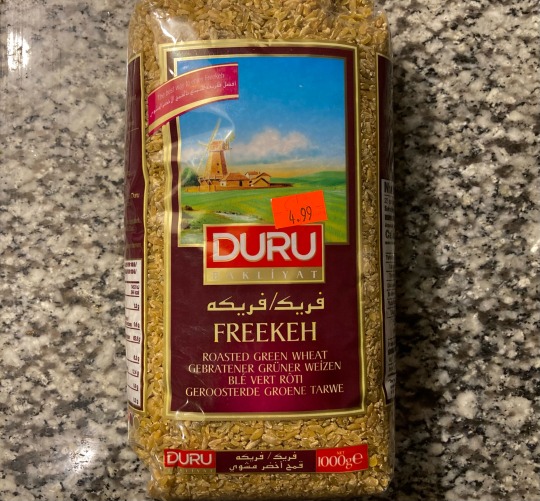
You may also be able to find frika at a speciality or health foods grocery store, but it might not have been fire-roasted as it is in the Levant. If your frika doesn't smell toasty, try roasting it in a dry pan on medium-heat for a few minutes until fragrant.
Frika may be found whole, cracked, or fine (نَاعِمَة / na'ima). You may use any kind for this soup; most people use cracked or fine frika, because of its shorter cooking time. You can pulse whole frika a few times in a food processor or spice mill, until coarsely ground, if you prefer a fine texture but can't find fine frika.
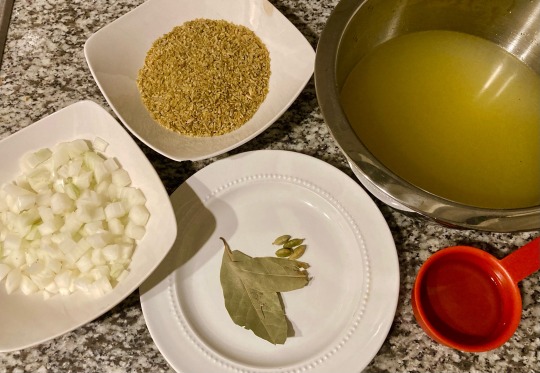
Instructions:
1. Heat olive oil in a large pot on medium. Add onion, a pinch of salt, cardamom pods, and bay leaves and fry, stirring occasionally, until the onion is golden brown.
2. Add the chili pepper and cook briefly until softened.
3. Add frika and black pepper and roast, stirring occasionally, for a few minutes until fragrant.
4. Add the water or stock and stir to combine. Bring to a fast simmer and cook, covered, about 50 minutes for whole frika and 20 minutes for ground, until fully cooked. Add additional water as necessary. The frika will still be chewy at the end of the cooking time.
5. Fry meat substitute of your choice in olive oil with salt, black pepper, and a optionally a pinch of Palestinian seven-spice, until browned. Add to soup and stir to combine. Taste the soup and add salt and more black pepper, if necessary.
6. Garnish with whole or chopped parsley and serve warm.
The meat is usually added to this soup just after the onions, and simmered along with the frika. You can do it this way if you like, but I have never found simmering to do the texture of meat substitutes any favors.
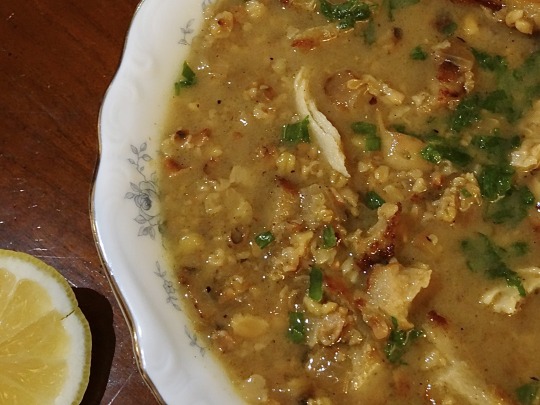
497 notes
·
View notes
Text

[ID: A glass bowl full of leafy greens, diced vegetables, and a lemon wedge. End ID]
Kale salad with baharat-roasted sweet potatoes, mint, and thyme
Roasted chickpeas, sweet potatoes, and golden beets are combined with leafy greens and fresh herbs in this bright, zesty Mediterrannean-inspired salad. A quick massage with salted oil makes the kale tender enough to eat, while the earthy and warming spices in Egyptian baharat lend complexity and aroma to the roast.
Recipe under the cut!
Patreon | Tip jar
Ingredients:
For the salad:
3 bunches curly kale, chard, or other leafy green, steps removed (270g without stems; 6 cups when chopped)
1 Tbsp good olive oil
1/2 tsp table salt
Small bunch parsley
Small bunch mint
For roasting:
1/2 cup cooked chickpeas
3 golden beets
1 sweet potato (I used a purple sweet potato)
2 tbsp olive oil
1/2 tsp seb'a baharat
1/4 tsp salt
3 sprigs thyme
3 cloves garlic, peeled and crushed
Dressing:
1 Tbsp olive oil
Juice of 1/2 lemon (1 1/2 Tbsp)
1/2 Tbsp balsamic vinegar
Crack of black pepper
1-2 tsp mirin or granulated sugar, to taste
Instructions:
For the vegetables:
1. Prepare the vegetables. Chop the beets and potatoes into small pieces of equal size, and remove the thyme leaves from their stems. Coat beets and potatoes in olive oil, baharat, salt, and thyme, then roast at 400 °F (200 °C) for 5 minutes.
2. Dry cooked chickpeas with a kitchen towel. Add them to the baking tray with the other vegetables and mix well. Roast for another 5 minutes.
3. Add peeled garlic to the baking tray and mix again. Roast for another 5 minutes, or until potatoes and beets are fork-tender.
For the salad:
1. Wash greens well in a colander. Remove stems and save for another purpose (such as pickling or mincing and adding to a soup). Roughly chop leaves and dry in a salad spinner, or by wrapping in a kitchen towel and spinning the towel around quickly.
2. In a large bowl, combine leaves with 1 Tbsp olive oil and 1/2 tsp salt. Massage the oil and salt into the leaves for a minute or two to soften.
3. Float parsley and mint in a bowl full of cool water to clean. Remove leaves from their stems and dry them with a kitchen towel. Roughly chop them and add them to the bowl with the greens.
For the dressing:
1. In a medium mixing bowl, combine all ingredients except oil.
2. Slowly add oil while whisking constantly, to emulsify.
To assemble:
1. Add roasted vegetables and dressing to the prepared greens and toss. Taste and adjust salt, pepper, lemon juice, and vinegar.
Serve immediately, as a side to a quiche or savory tart.
90 notes
·
View notes